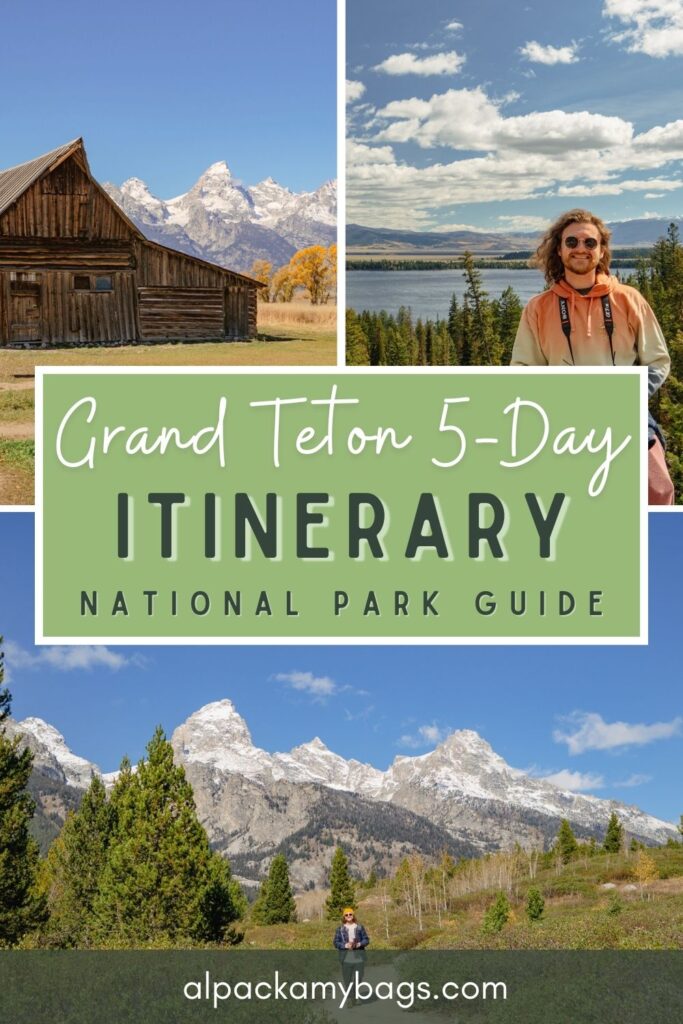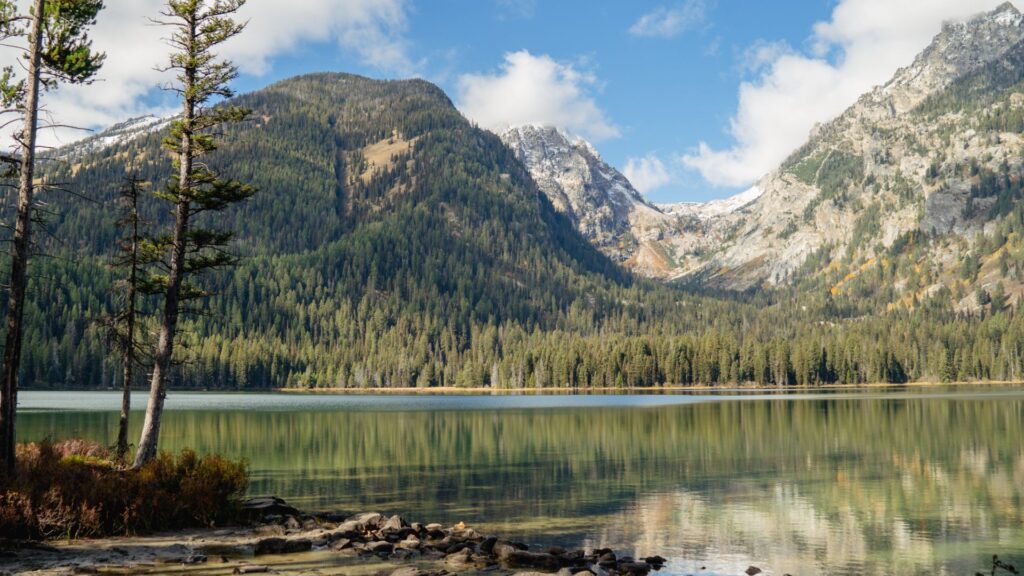
Welcome to Wyoming, an underrated state if you ask me, and home to Grand Teton National Park. With wide open spaces (queue the Dixie Chicks), alpine lakes, and a spectacular mountain range, this US national park has plenty to offer.
In this post, we’ll cover trip planning like how to get to Grand Teton, where to stay, and what pack, the best Grand Teton itinerary for 5 days of hiking and views, and other recommendations for having a successful trip.
I had high expectations for this Wyoming nature gem and somehow it blew past them! I’m a huge hiking fan so I’ll share some of my favorite hikes in my Grand Teton vacation planner, but you can also enjoy this park from the comfort of your car, with a tour guide, or even from the back of a horse!
There are so many fun things to do in Grand Teton National Park, and if you have about 5 days to explore here, keep reading to find out how to spend them! This Grand Teton itinerary is hiking-focused as that’s what I can highly recommend.
Disclosure: This article may contain affiliate links, meaning we get a small commission at no extra cost to you if you make a purchase through one of them. Read our affiliate disclosure. Thank you for your support!
In this article…

Park Overview
Open: year-round, but many facilities and roads close in the winter
Entrance Fee: $35 per vehicle good for 7 days, $70 annual pass
Size: 310,000 acres
Tallest Peak: Grand Teton at 13,775 feet
Wildlife: Moose, bears, deer, pikas, pronghorn, elk, bison, and more
Park Established: February 26, 1929
TIP: If you plan on visiting more national parks, consider buying the “America the Beautiful” Pass. This is the annual US National Parks pass that allows you access to all the national parks as well as hundreds of other national sites and monuments.
Pre-Trip Prep: Grand Teton Itinerary
Before you head to this park yourself, here are some helpful tips to plan your trip. From getting to Grand Teton, to packing, and where to stay, let’s plan an epic trip for you! You will need a car to explore this national park as it’s rather large and there is no shuttle service.
Airports Near Grand Teton National Park
If you plan on flying here, the closest airport to Grand Teton National Park is Jackson Hole Airport (JAC). This airport is actually in the national park itself, the only one like it in the United States! There are rental cars available at JAC as well.
The second closest airport is Idaho Falls Airport; this regional airport is about 2 hours west of Grand Teton National Park.
The closest international airports to Grand Teton are Bozeman Yellowstone International Airport (BZN), about 4 hours away, and Salt Lake City International Airport (SLC), about 5 hours away. You will need to rent a car from any of these and drive to the park.
Jackson Hole Airport (JAC): In Grand Teton National Park
Idaho Falls Airport (IDA): 96 miles | 2 hour drive
Bozeman Yellowstone International Airport (BZN): 166 miles | 4 hour drive
Salt Lake City International Airport (SLC): 286 miles | 5 hour drive
You will need to rent a car from any airport you fly into; Grand Teton National Park is most easily explored by car.
When driving to Grand Teton National Park, you’ll likely come in on Highway 191 which runs north and south between Jackson, Wyoming, Grand Teton National Park, Yellowstone National Park, and Bozeman, Montana.
Read Next: 9 Best Hikes in Big Bend National Park

Lodging & Camping in Grand Teton National Park
There are multiple campsites and lodges within the national park, you never need to leave once you arrive. There are even gas stations and convenience stores with food and other supplies in the park. There are six different permanent lodging facilities available in Grand Teton; you can stay in a cabin, motel-style lodge, dude ranch, or lakefront lodge.
Camping is also a great option. There are six official campgrounds in Grand Teton National Park. Every campground has potable water. You are required to make reservations for all campsites.
Gros Ventre Campground: We stayed here and highly recommend it. It’s located in the southeastern corner of the park and is about 15 minutes from Jackson. There are several electric hookup sites and bathrooms, but no showers.
Jenny Lake Campground: This is a tent-only campground located right next to Jenny Lake.
Signal Mountain Campground: This smaller campground has a few electric sites, pay showers, and laundry nearby. It’s located on the southern end of Jackson Lake.
Colter Bay: This area has a campground, RV park, and tent cabins. There are pay showers and laundry in Colter Bay.
Lizard Creek Campground: Located in northern Grand Teton National Park, Lizard Creek has 60 standard sites with no electric hookups.
Headwaters Campground: This campground, located the farthest north near Yellowstone National Park, offers full-hookup sites, standard non-electric sites, and camper cabins for those without a tent or RV. Showers are included.

There are also campgrounds just outside of the national park, including some in the Bridger-Teton National Forest which borders the national park. Campsites do require reservations.
For reservations in the adjacent national forest, check the availability here. Keep in mind that campsites in the park are generally only open from May through October. Check availability before planning your trip.
Backcountry camping is also available in Grand Teton National Park. You do need to obtain a permit for any backcountry camping before you hit the trail. Head to the NPS website to do so, or stop by one of the visitor centers.
You can also rent an RV or camper trailer to stay in the park. Bozeman and Salt Lake City will have the most options if you want to drive from one of those airports into Grand Teton National Park. Cruise America is a popular company with decent options.
New to camping? Here are all the camping essentials you need for a successful trip!
Cities Near Grand Teton National Park
If you don’t want to camp in the park or stay in one of the Grand Teton lodges, there are other hotel and lodging options nearby. The closest city to the main entrance of Grand Teton National Park, Moose Entrance, is Jackson, Wyoming.
Jackson is about a 20-minute drive to Moose Entrance making it a great base for exploring the Tetons. There are plenty of restaurants, shops, and activities in Jackson to enjoy while you’re not in the national park.
Here are my top recommendations for the best hotels in Jackson:
Elk Country Inn | Breakfast included & hot tub
Ranch Inn Jackson Hole | Right in downtown Jackson
Flat Creek Inn | Budget & closer to Moose Entrance
Looking for food? Jackson has no shortage of great restaurants. Here are some of my favorites that have great vegetarian options:
Cowboy Coffee Co | Breakfast and Coffee
Hand Fire Pizza | Wood-fired pizza
Snake River Brewing Co | Brewery with food
Liberty Burger | Hamburgers (veggie options)
Koi Sushi and Poke | Sushi restaurant
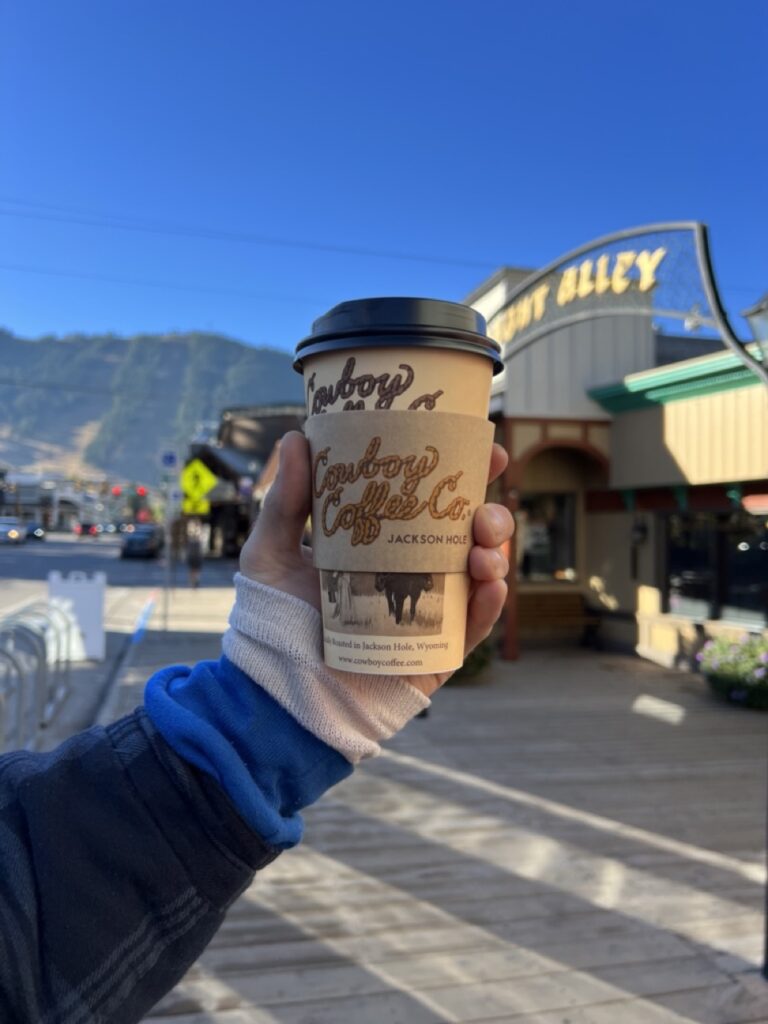
In the park, there is also Dornan’s Pizza Pasta Company, a highly-rated pizza restaurant with rooftop views of the Tetons! It’s just outside the Moose Entrance.
Another nearby town is Teton Village. It’s smaller so there are fewer lodging options, but if you want to stay somewhere quieter, Teton Village could be a good choice for you. It’s only a 30-minute drive to Moose Entrance from Teton Village.
What to Pack for Grand Teton National Park
1. FOOD
It’s likely you’ll want to pack some sort of food for your full days exploring the park. If you’re flying in, don’t worry about this one until you make it to Jackson. There are grocery stores here where you can load up on plenty of snacks, sandwich ingredients, whatever you please.
If you’re going to hike, I recommend bringing high energy snacks like trail mix, energy bars, possibly candy, and some fruit like bananas. For longer hikes, or if you want to picnic while on a trail, bring something easy to carry like a sandwich or wrap.
Remember you’re in bear country; store food in a bear canister, bear box, or in your car. While hiking, I recommend using an odor-proof bag to keep your food in.
2. CLOTHES
This really depends on the season you’re visiting as temps vary in the Tetons year round, but in general, I recommend packing plenty of layers. When layering clothes, I start with a t-shirt or tank top, add a warmer layer like a fleece pullover, and finally a down jacket.
In summer, you’ll likely be fine with just two layers, but remember it can still get very cold in the evening and early morning. Sometimes it drops down to the 30s (°F) in August and July, which is why layers are best all year.
Hikers! I highly recommend these REI women’s hiking pants. I wore them in Grand Teton in October and I was perfectly comfortable, but you can also make them into shorts for summer hiking! They’re available in men’s as well.
3. HIKING GEAR
This itinerary is mainly hiking focused as Grand Teton has so many amazing hiking trails. If you do plan on hiking, check out my day hiking essentials list so you’re well-prepared for an adventure on the trail! You won’t be disappointed by the trails in this park.
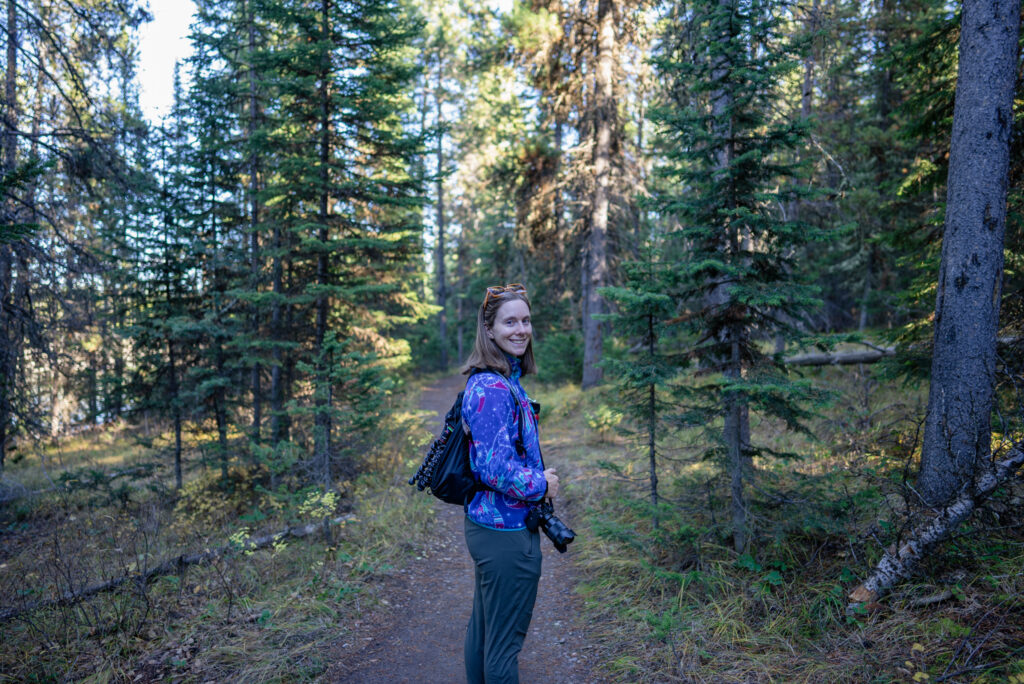
4. BEAR PROTECTION
You’re going to bear country, so you’ll definitely want to have bear spray and a bear bell with you. If you’re flying to Grand Teton National Park, wait until you get to Jackson to buy bear spray. If you’re driving from home, you can buy it before you leave for your trip.
We both carried bear spray with us on every hike but did not encounter a single bear in our five days at the park. However, it’s better to be safe than sorry when in bear country.
For hiking, I recommend putting your food in odor-proof bags. They’re easier to carry in a backpack than a bear canister. If you’re camping in Grand Teton National Park, remember to put all your food in the bear boxes provided or locked in your car.
5. CAMPING ESSENTIALS
Hey fellow campers! There are multiple campsites in Grand Teton National Park making it a great option for lodging. If you do plan on camping here, make sure you have all the camping essentials you need for a fun and comfortable outdoor experience. Camping is a great way to enjoy the Tetons.
6. SEASONAL GEAR
Summer can get quite cold in Grand Teton National Park, so you can imagine what fall and spring are like. With much cooler weather, remember to pack extra layers if you’re visiting during the colder weather months (September through June).
Grand Teton is mainly closed during the winter (November through April) as the roads get icy and visitor facilities close. Spring brings the possibility of snow still on the ground so wear proper shoes if you’re hiking.
My women’s Salomon hiking boots are so comfortable, light, and waterproof! These are also available in men’s.
Planning to camp even if it’s chilly? Here’s how to stay warm while camping in cold weather.
Best Time to Visit Grand Teton National Park
The Teton Range is breathtaking any time of year; the best time to visit Grand Teton National Park depends on what you wish to do. June through August are the warmest months, but bring larger crowds.
September through October are cooler, but there are generally fewer people. November through May are snowy and icy, but this can still be a beautiful time to experience the Tetons.
Hiking and other activities like kayaking are optimal from June through October. Summer temperatures generally stay between the mid-70s to mid-60s (°F), but this time of year also attracts the most people.

Teton Park Road, the main road that runs north and south through the park, is closed from November through April to vehicles. Visitor centers also close or greatly reduce their hours during these winter months, and hiking isn’t much of an option. However, winter in Grand Teton National Park is great for snowshoeing and cross-country skiing.
In general, the best time to visit Grand Teton National Park is October. You won’t run into the huge summer crowds, some campsites are still open at the beginning of the month, the weather is perfect for hiking, and there’s a sprinkle of snow blanketing the mountain peaks.
Grand Teton Itinerary: 5 Days
This is a suggestion for a 5-day Grand Teton itinerary. I enjoyed spending my time here this way, and if you love hiking too, I think you’ll find it to be a good itinerary!
We’re average hikers and pushed ourselves a little on this trip so feel free to increase or decrease the amount of hiking you do.
This itinerary is based on arriving at the park on day 1 and leaving the park on day 5. If you only have two or three days to explore, the hikes below are my top recommendations for Grand Teton National Park trails, so pick your favorites and hit the trail in whatever order you want!
In order to avoid the largest crowds, it’s best to start your days early. If you can, try to be on the trails before 9 am. The parking lots fill up quickly here, and you probably want to enjoy some peace and quiet while hiking.
Below the Grand Teton itinerary, you’ll find suggestions for other fun things to do in Grand Teton National Park. Not only are there breathtaking hikes, this park has so much to offer to everyone!
DAY 1
Arrive at Grand Teton National Park in the afternoon.
If you get to the park before 3 pm, you will still have time to enjoy some hiking.
Head to the Leigh Lake Trailhead parking lot to hike String Lake and Leigh Lake Trails.
Leigh Lake Trail – Short Version | 1.5 miles to String Lake Trail
String Lake Trail | 3.7 miles
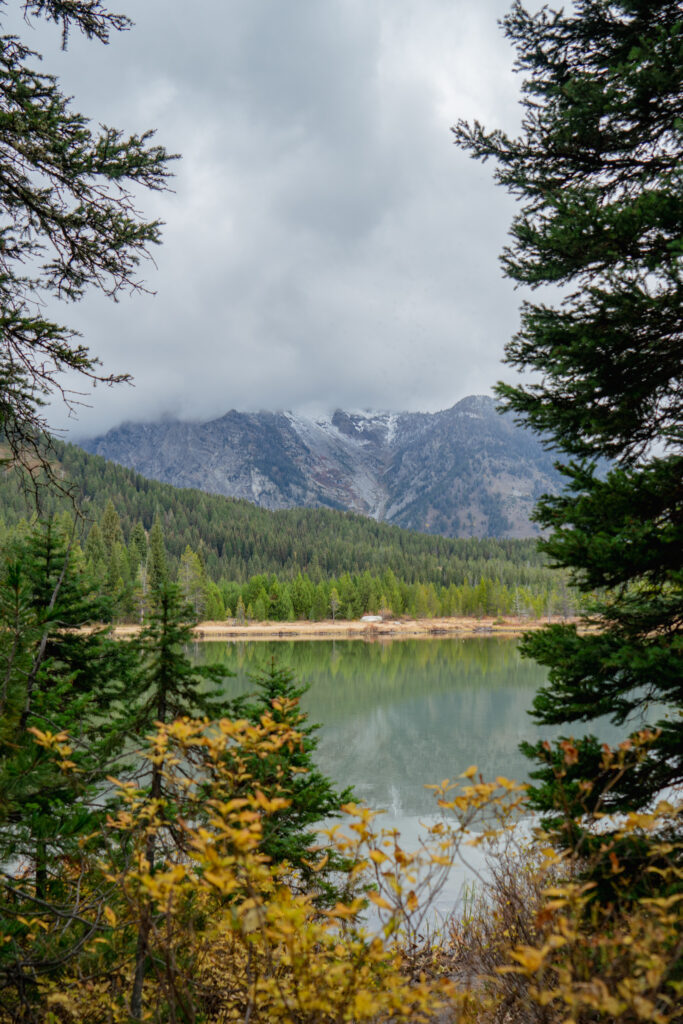
Start hiking the Leigh Lake Trail. It’s about 1.25 miles to the lakeshore. You can go further if you like, or turn around and head back the way you came. About 0.25 miles back there is a wooden bridge you can cross; this will put you on the String Lake Trail.
In total, it’s about 4.5 miles if you hike the Leigh Lake short version and continue on to String Lake.
Short on time? I recommend sticking to just Leigh Lake. It’s a flat hike and the views are absolutely stunning.
Head back to camp and cook some dinner! Or go back to your hotel for a cozy night in.
DAY 2
Rise and shine…after a quick breakfast, head to Jenny Lake for a busy day!
Once you’ve parked at the Jenny Lake Trailhead lot, hit the trail. We’re going partially around Jenny Lake, up to Hidden Falls and Inspiration Point, and into Cascade Canyon today.
Jenny Lake to Hidden Falls | 2.6 miles
Hidden Falls to Inspiration Point | 0.5 miles uphill
Inspiration Point to Cascade Canyon | 8 miles
I recommend going to Hidden Falls first then making your way to Inspiration Point. This is where we stopped for a lunch break (because amazing view!), and then we continued on to Cascade Canyon.
This is an out-and-back route so from Cascade Canyon, you’ll make your way back to the Jenny Lake parking lot. Cascade Canyon is about 8 miles round trip from Inspiration Point; however, you don’t need to hike the whole thing if you don’t wish to.
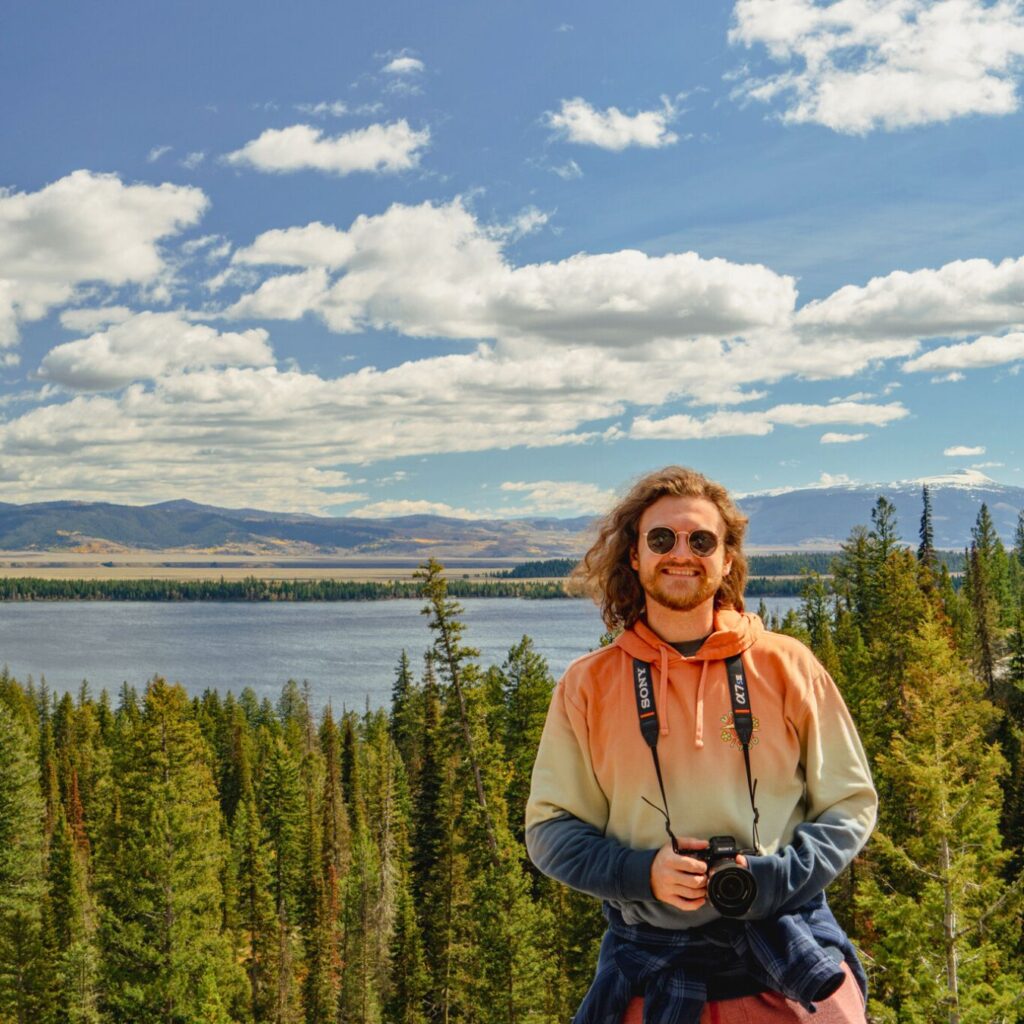
We hiked around a mile from Inspiration Point into Cascade Canyon, admired the views, took many photos, and made our way back. Once we made it to the open canyon, we were pleased with our hike so we decided to head back.
Once you get back to the Jenny Lake parking lot, it’s time for dinner and a good night’s sleep.
DAY 3
Ready for another day of breathtaking views? Today we’ll go a little easier, and head to Taggart and Bradley Lake first.
Make sure you get to the Taggart Lake Trailhead parking lot early; this one fills up quickly.
You can do both of the following trails as a loop, or stick to just Taggart Lake for a shorter hike. You have to hike past Taggart to get to Bradley, so it’s a longer hike in total.
Taggart Lake Loop | 3.8 mile loop
Taggart and Bradley Lake Loop | 6 mile loop
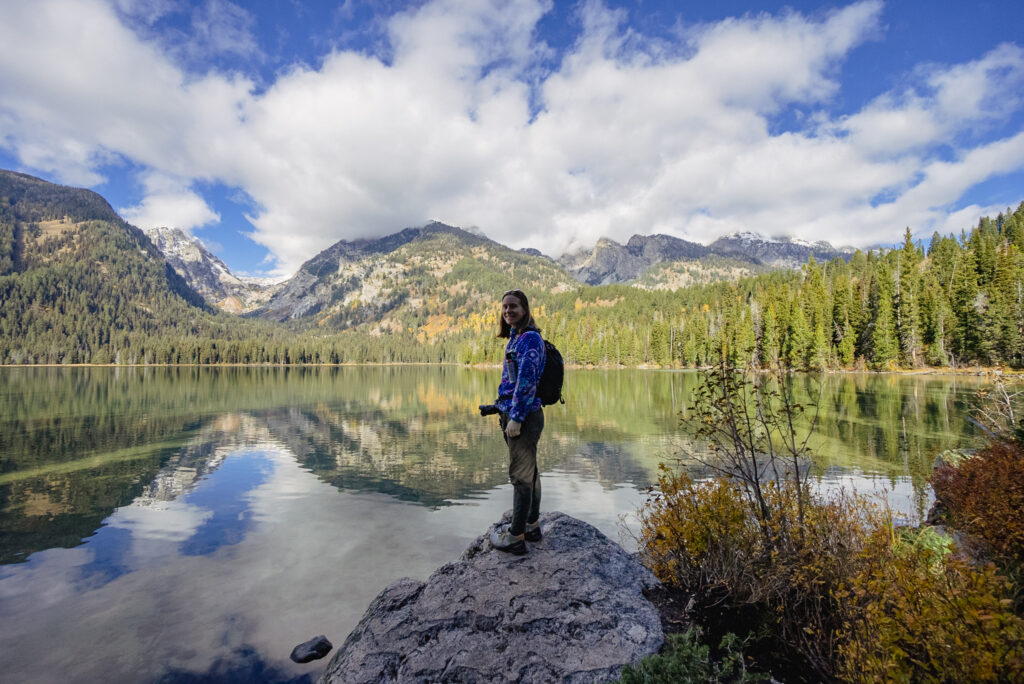
You can also hike this as an out-and-back which is what we did. Round trip to Taggart Lake only and back is about 3 miles, so slightly shorter than the loop trail. If you add Bradley Lake to this route, it’s just under 6 miles at about 5.8 miles roundtrip. Continue on from Taggart to get to Bradley Lake.
Up next is the T.A. Moulton Barn, a significant monument in Grand Teton National Park.
There’s a good chance you’ve seen photos of this barn when searching Grand Teton National Park; it’s a popular place to visit and is easy to get to.
Mormon Row’s Moulton Barn | 0.2 miles loop
You can switch the order of today’s hikes if you wish to see the sunrise at the Moulton Barn. It’s a popular place to catch the sunrise, so start your day extra early here if you please, and make your way to Taggart and Bradley Lakes after.
If you have time for more hiking, visit the northern part of Grand Teton for slightly different, yet still incredible views. Colter Bay Lakeshore is a much quieter area, but still a great place to hike.
Colter Bay Lakeshore | 2.5 mile loop
Colter Bay is a nice place to catch the sunset. If you time your hike to end in the evening here, go to the picnic area just off the Lakeshore trail by the amphitheater to sit down and enjoy the sunset.
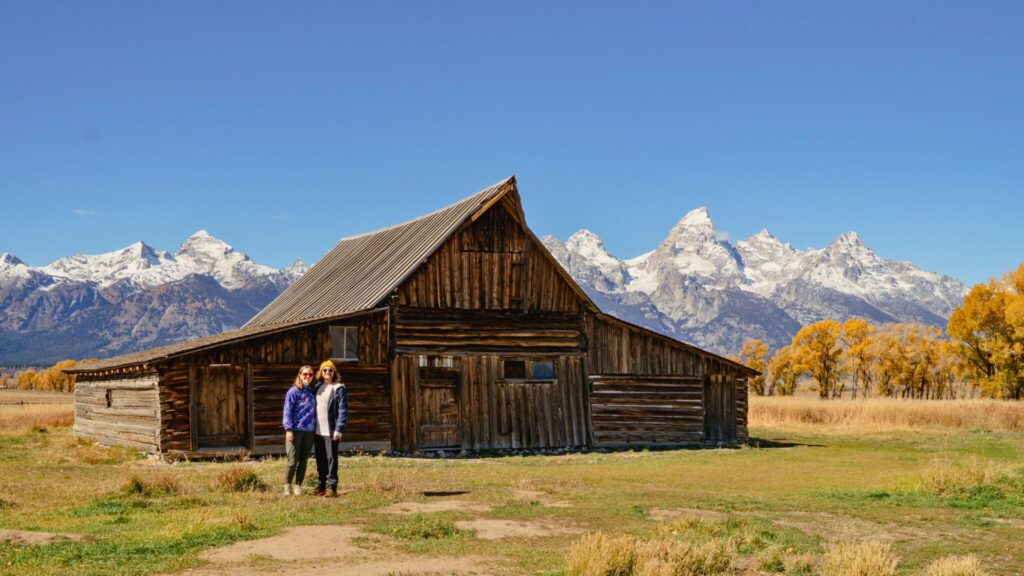
DAY 4
Today’s a big day! One of the best hikes in Grand Teton National Park, and we saved it for last. If you’re an experienced hiker, you’ll likely be fine on this trail. But as somewhat average hikers, it kicked our butts.
It’s time to hike to Delta Lake! This lake sits below the peak of Grand Teton itself and provides phenomenal views of icy blue water, snow-capped mountains, and the open plains beyond.
Delta Lake | 7.4 miles out-and-back
The Delta Lake trail starts at the Lupine Meadows Trailhead (park here). It’s not the best signed trail, as it’s not officially a designated trail. Many people do it, so you’ll likely see others along the way, but you’ll definitely want AllTrails downloaded for this one.
It’s a pretty difficult hike as it’s uphill the entire way there. The last mile includes climbing over some boulders and a very steep incline to get to the lake. It’s so worth it, but know your limits so you don’t put yourself in danger. Remember, you’ll have to hike back if you hike there.
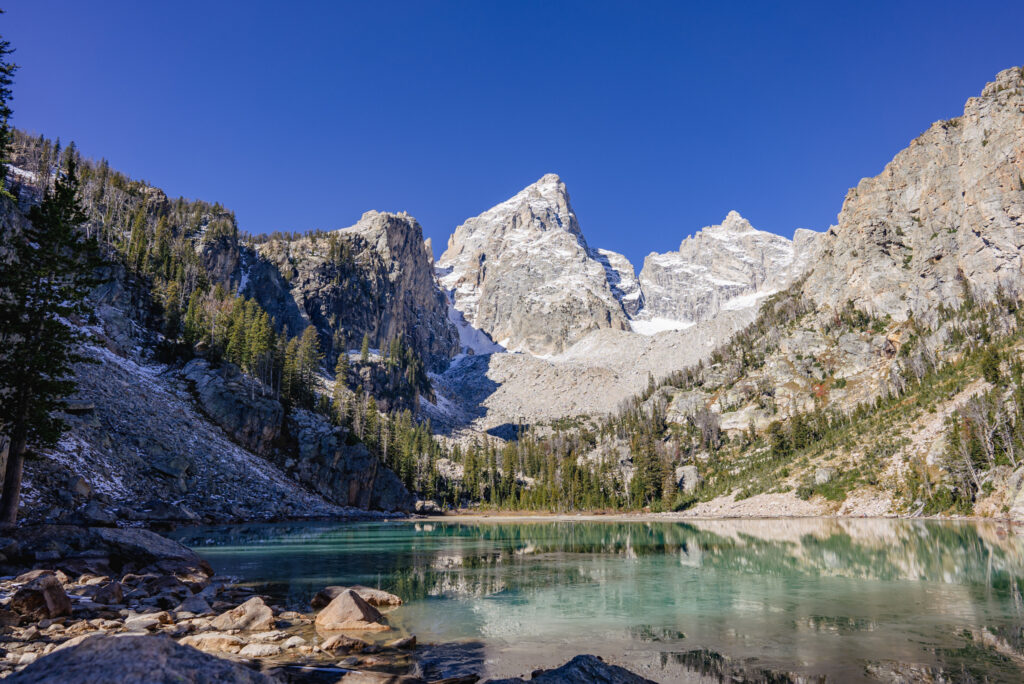
On day 4 we treated ourselves to a night in Jackson. After hiking to Delta Lake it was just what we needed!
Go to Hand Fire Pizza for dinner; it’s so fresh and delicious and their vegetarian options are amazing. After pizza, enjoy a drink at Snake River Brewing Co. and sit around the outdoor fire for a relaxing end to your day.
DAY 5
The last day has arrived and it’s time to go home or move onto your next destination. If you’re camping or staying at a national park lodge, head into Jackson for some breakfast at Cowboy Coffee Co. They have delicious coffee and a killer breakfast burrito (vegetarian too!).
Depending on when you’re leaving, you might have time for another hike. Here are my suggestions…
Moose Ponds Trail | 3.2 mile loop
South Landing Trail via S Landing Lagoon Road | 3.8 mile out-and-back
Lake of the Crags Trail | 5 mile out-and-back
After breakfast or a hike, depending on what you have time for, it’s time to say see you later to the breathtaking Tetons. They’re truly spectacular; I can’t stop thinking about this Grand Teton itinerary and how I want to go back and do it all again!

Other Things to Do in Grand Teton National Park
Hiking | The most popular activity in Grand Teton National Park is hiking, with good reason. This national park boasts incredible trails varying in length and difficulty making it a great place for any level hiker. The hikes included in the above Grand Teton itinerary are the best hikes in the park.
Horseback Riding | Pretend you’re in a Western movie and hop on a horse to enjoy the views of Grand Teton. What a cool way to explore the park! There are several tour operators to choose from offering multiple different rides. Check out Grand Teton Lodge Company if you’re interested.
Biking | A popular way to enjoy Grand Teton National Park is by bike. There is a paved trail, Grand Teton Pathway, that you can follow from Jackson to Antelope Flats Road.
You can also bike on roads or the paved trail that follows Teton Park Road from Moose Entrance to Jenny Lake, but you cannot bike on hiking trails. Visit Bridger-Teton National Forest for mountain biking opportunities.
Paddling | Kayaking, canoeing, paddle boarding, and boating are allowed on several of the lakes in Grand Teton National Park. You can bring your own or rent a kayak, canoe, etc. You will need to acquire a permit before entering the water with any watercraft.
Scenic Drive | Along with hiking, another great way to admire Grand Teton’s views is by going on a scenic drive. You can drive along Teton Park Road, the main road, and stop at any turnouts for photos and viewing opportunities. Other scenic drives include, Signal Mountain Summit Road, Moose-Wilson Road, and Jenny Lake Scenic Drive.
Fishing | If you enjoy fishing, get yourself a Wyoming fishing license and enjoy Grand Teton National Park’s lakes. There are plenty of lakes and rivers to choose from here. Remember to follow all rules and regulations regarding fishing in the park.
Wildlife Viewing | There is so much wildlife to admire in the Tetons. Here you can find moose, bears, deer, pikas, eagles, elk, and more. If you’re interested in wildlife viewing or photography, you can learn more on the NPS website.
Mountaineering | If you’re an experienced climber, add some mountaineering routes to your Grand Teton itinerary. This national park is well known for its climbing opportunities. Make sure you are well prepared for your trek, from gear to weather, etc. This is not a beginner activity.
Snowshoeing & Cross-Country Skiing | While Teton Park Road is closed to vehicles in the winter months, you can ski, snowshoe, or walk it and admire the snow covered Teton Range. You can also ski, snowshoe, or walk Moose-Wilson Road and Phelps Lake in the winter.

Best Tours in Grand Teton National Park
Want to experience the nature, wildlife, and history of Grand Teton National Park with a knowledgeable guide? A tour could be a great option for you. Below are the top-rated tours in Grand Teton National Park as well as some popular tours nearby.
4-Hour Guided Wildlife Adventure: From $139 per person
Winter Day Trip With Horse-Drawn Sleigh Ride: From $199 per person
Grand Teton: Self-Guided Audio Driving Tour: From $20 per group
Whitewater Rafting in Jackson: From $105 per person
Bridger-Teton National Forest Horseback Ride: From $104 per person
Grand Teton Itinerary: Tips & Useful Info
To help you make your adventure trip the best possible, I’ve gathered the most helpful tips below. From apps to seasonal considerations, this is more than just an itinerary, it’s a Grand Teton vacation planner!
Apps you need for your Grand Teton trip:
- Google Maps | Download the Grand Teton National Park map so you can navigate around the park even if your cell signal is spotty (both Verizon and AT&T were spotty in some areas).
- AllTrails + | Being able to download trail maps for offline use is very helpful, especially for hikes like Delta Lake; they have a free 7-day trail as well.
- NPS App | For self-guided audio tours, maps, and more information about Grand Teton National Park, you can download the National Park Service (NPS) app.
Seasonal Considerations:
Grand Teton National Park is generally closed from November through April. Driving conditions are not optimal this time of year, so Teton Park Road closes, which is the main road throughout the entire park.
In the winter months, the visitor facilities also close or have very limited hours. As well as roads being closed due to snow and ice, the trails are not suitable for hiking this time of year. However, snowshoeing and cross-country skiing are very popular alternatives for enjoying the park in winter!
Campgrounds also have seasonal schedules. The campgrounds in Grand Teton National Park are open from May through October. Some of them open later, and some close as early as September.
Summer brings the most visitors to Grand Teton National Park, making July and August the busiest months to visit. If you want to avoid crowds as best you can, I recommend visiting the park in early June or late September through October.
READ NEXT: 5 Best Budget Stays in Jackson, Wyoming
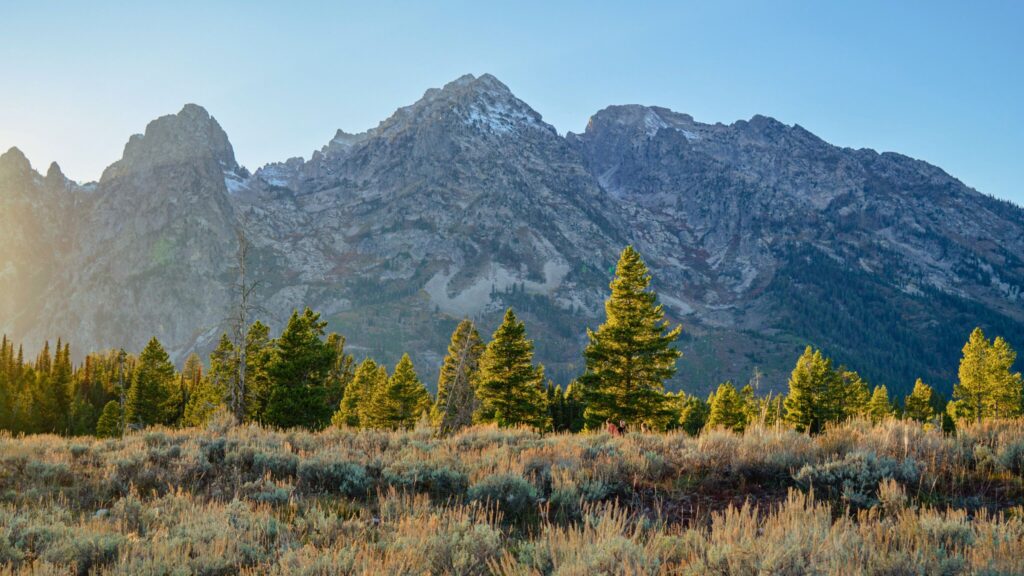
FAQ: Grand Teton Itinerary
How many days do you need in Grand Teton?
This Grand Teton Itinerary covers 5 days of exploring the national park. You can easily see the most popular places in the park in only 2 or 3 days.
If you have 5 days here, you can also spend one or two of them exploring Yellowstone National Park which is only a 2 hour drive away. Many visitors opt to see both parks in one trip.
Is Grand Teton better than Yellowstone?
Both Yellowstone and Grand Teton National Park are worth visiting if you have the time. Yellowstone is much bigger and more well known so it is generally busier.
Grand Teton National Park is smaller and less busy, yet it still has so much to offer. It’s an underrated US national park, often beaten by Yellowstone, Yosemite, and other more popular parks. But Grand Teton has many hiking trails to enjoy surreal views, gorgeous lakes to fish and paddle on, and so much wildlife to see.

Time to start planning a return trip to Grand Teton National Park before you even leave! But seriously, this park is phenomenal, it’s one of my favorite US national parks to date. With this ultimate Grand Teton itinerary, you can check off some of the park’s best views and tackle the best hikes.
As well as knowing how to spend 5 days in Grand Teton National Park, you now know how to get here, where to stay, what to pack, the best time to visit, what apps you need to make the most of your trip, and other fun things to do in the park.
This Wyoming national park has a lot to offer; it will leave you wanting to come back for more mountainous views, wildlife spotting, and incredible landscapes. Plan your own trip here with the itinerary above. It’s the best Grand Teton vacation planner to help you enjoy this national park to its fullest!

